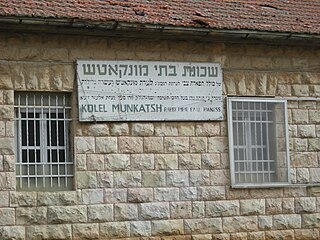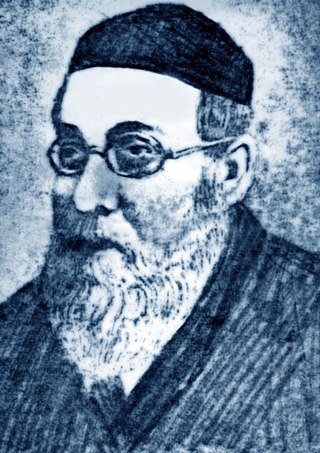
Zikhron Ya'akov is a Moshava (town) in Israel, 35 kilometres (22 mi) south of Haifa, and part of the Haifa District. It is located at the southern end of the Carmel mountain range overlooking the Mediterranean Sea, near the coastal highway. It was one of the first Moshavot of Halutzim in the country, founded in 1882 by Romanian Jews, who in 1883 received support from Baron Edmond James de Rothschild and renamed their town in honor of his father, James Mayer de Rothschild. In 2022 it had a population of 24,145.

Shaar Hashamayim Yeshiva is an Ashkenazi yeshiva in Jerusalem dedicated to the study of the kabbalistic teachings of the Arizal. It is famous for its student body of advanced kabbalists — many of them roshei yeshiva and Torah scholars — as well as beginning and intermediate scholars who study both the revealed and concealed Torah.

Nachlaot is a cluster of 23 courtyard neighborhoods in central Jerusalem surrounding the Mahane Yehuda Market. It is known for its narrow, winding lanes, old-style housing, hidden courtyards and many small synagogues.

This article deals in more detail with some of the notable synagogues of Jerusalem that do not have their own page as yet.

Rabbi Meir Auerbach (1815–1878) was president of the Jewish court at Koło, and author of Imrei Bina. After his immigration to Ottoman Palestine in 1859, he headed the Poland Kollel and became the first Ashkenazi Chief Rabbi of Jerusalem.

Ezrat Torah is a Haredi neighborhood in northern Jerusalem. It is bordered by Kiryat Sanz on the west, Golda Meir Blvd. on the north and east, and Shikun Chabad and Tel Arza on the south.
Zikhron Yosef is a former courtyard neighborhood in Jerusalem. The neighborhood was established in 1927 near the Mahane Yehuda Market by Kurdish Jewish immigrants who used to live in the Old City of Jerusalem. The neighborhood is named after its former landowner Joseph Levy, whose son sold the land on condition that the neighborhood would be named after his father.

The Zoharei Chama Synagogue, also spelled Zohorei Chama, colloquially known as the Sundial Building or Mahane Yehuda Clock Tower, is an Orthodox Jewish congregation and synagogue, located on Jaffa Road in Jerusalem, Israel.

The expansion of Jerusalem outside of the Old City walls, which included shifting the city center to the new neighborhoods, started in the mid-19th century and by the early 20th century had entirely transformed the city. Prior to the 19th century, the main built up areas outside the walls were the complex around King David's Tomb on the southern Mount Zion, and the village of Silwan.
Nisan Bak was a leader of the Hasidic Jewish community of the Old Yishuv in Ottoman Palestine. He was the founder of two Jewish neighborhoods in Jerusalem, Kirya Ne'emana and a Yemenite Jewish neighborhood, and builder of the Tiferet Yisrael Synagogue, also known as the Nisan Bak Shul.

Sanhedria Cemetery is a 27-dunam (6.67-acre) Jewish burial ground in the Sanhedria neighborhood of Jerusalem, adjacent to the intersection of Levi Eshkol Boulevard, Shmuel HaNavi Street, and Bar-Ilan Street. Unlike the Mount of Olives and Har HaMenuchot cemeteries that are located on the outer edges of the city, Sanhedria Cemetery is situated in the heart of western Jerusalem, in proximity to residential housing. It is operated under the jurisdiction of the Kehilat Yerushalayim chevra kadisha and accepts Jews from all religious communities. As of the 2000s, the cemetery is nearly filled to capacity.

Batei Saidoff is a former courtyard neighborhood in western Jerusalem. Erected by Yitzhak Saidoff, a wealthy Bukharan Jew, in 1911, it was one of a series of courtyard neighborhoods built along Jaffa Road in the late 19th and early 20th centuries, together with Sha'arei Yerushalayim and Ohel Shlomo. In the 2000s the two buildings facing Jaffa Road were evacuated of tenants and redeveloped as upscale shops, and a 23-story luxury residential tower was constructed south of the courtyard.

Ohel Shlomo is a historical courtyard neighborhood in western Jerusalem. It is one of a series of courtyard neighborhoods built along Jaffa Road in the late 19th and early 20th centuries, together with Sha'arei Yerushalayim and Batei Saidoff. Today it is considered part of the Mekor Baruch neighborhood.

Batei Munkacs, also spelled Batei Munkatch, officially Batei Munkacs Tiferes Zvi, is a former courtyard neighborhood in Jerusalem. Established in 1928 by the Munkacser Rebbe, Rabbi Chaim Elazar Spira, Batei Munkacs is now part of the Nachlaot neighborhood.

Kirya Ne'emana, commonly known as Batei Nissan Bak was a historical Hasidic Jewish neighborhood established opposite Damascus Gate in the New City of Jerusalem in 1875. In the 1880s and 1890s it was joined by additional housing for Syrian, Iraqi, Persian, Georgian, and Caucasian Jews. Most of the residents fled the area during the 1929 Palestine riots and their houses were occupied by Christians and Muslims. In the 2000s a handful of Jewish families reclaimed houses in the neighborhood.

Knesset Yisrael, also known as Knesset, is the name of a group of three former courtyard neighborhoods in central Jerusalem. Known as Knesset Aleph, Knesset Bet, and Knesset Gimmel, the housing project was planned by the Vaad HaKlali Knesset Yisrael and funded by overseas Jewish donors. The houses were completed in stages from 1892 to 1926. Beneficiaries of the housing were poor Haredi Ashkenazi families and Torah scholars connected to the Central Committee kolel system. Today Knesset Yisrael is part of the Nachlaot neighborhood.

Even Yisrael is a former courtyard neighborhood in Jerusalem. Built in 1875, it was the sixth Jewish neighborhood to be established outside the Old City walls. It is now part of the Nachlaot neighborhood. In 2004 the neighborhood underwent preservation and renovation by the Jerusalem Municipality, which re-paved and re-landscaped the central courtyard and added a small stone amphitheater for tour groups and daytime passersby.

Yosef Yitzhak "Yoshya" Rivlin was an Orthodox Jewish scholar, writer, and community leader in the Old Yishuv of Jerusalem. Scion of a family of Perushim, disciples of the Vilna Gaon who immigrated to Israel in the early 19th century, Rivlin spearheaded the establishment of the first Jewish neighborhoods outside the Old City walls. He helped found a total of 13 neighborhoods, beginning with Nahalat Shiv'a and Mea Shearim. His activities earned him the nickname Shtetlmacher ("Town-Maker"). He directed the Central Committee of Knesseth Israel, the supreme council of the Ashkenazi community in the Old Yishuv, for over 30 years.

Mahane Yehuda is a historic neighborhood in Jerusalem. Established on the north side of Jaffa Road in 1887, it was planned and managed by the consortium of Swiss-Christian banker Johannes Frutiger and his Jewish partners, Joseph Navon and Shalom Konstrum. By the end of the 19th century, it encompassed 162 homes. Originally occupied by upper middle-class residents, it became a working-class neighborhood beginning in the late 1920s. Today the neighborhood is part of Nachlaot. The Mahane Yehuda Market located across the street was named after the neighborhood.

Mashiach Borochoff House is a historical building located at 64 Jaffa Road in Jerusalem. Built in 1908 in eclectic style, its entrance is covered by an arcade with pointed arches supported by pseudo-Corinthian columns. The gate, in the style of 17th-century Georgian architecture, consists of two pillars connected by ironwork. A lion statue is placed atop each pillar. The house was built by Mashiach Borochoff, a wealthy Bukharan Jewish merchant, as a family residence. In 1947, a year after Borochoff's death, the property was sold to Barclays bank. It has functioned as a bank branch since that time.























